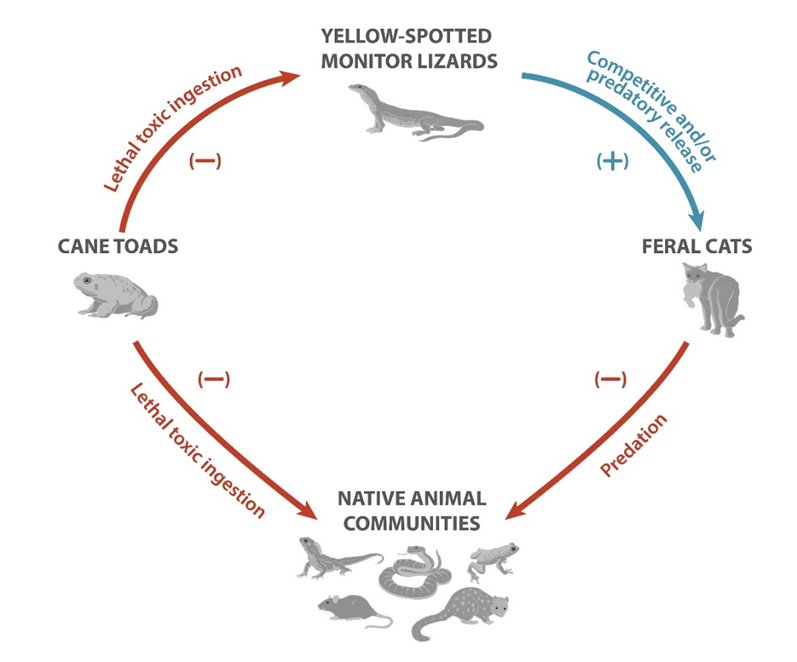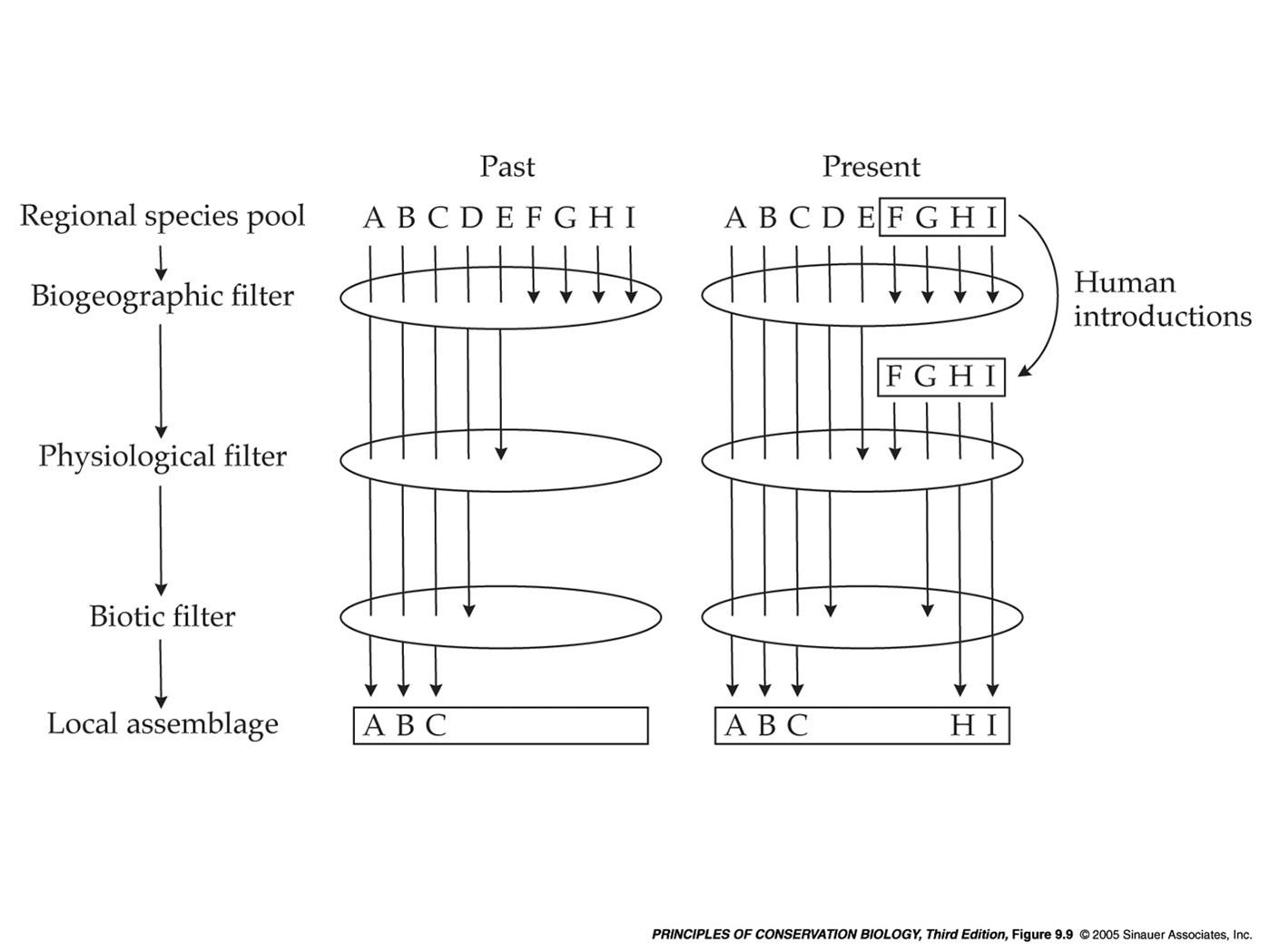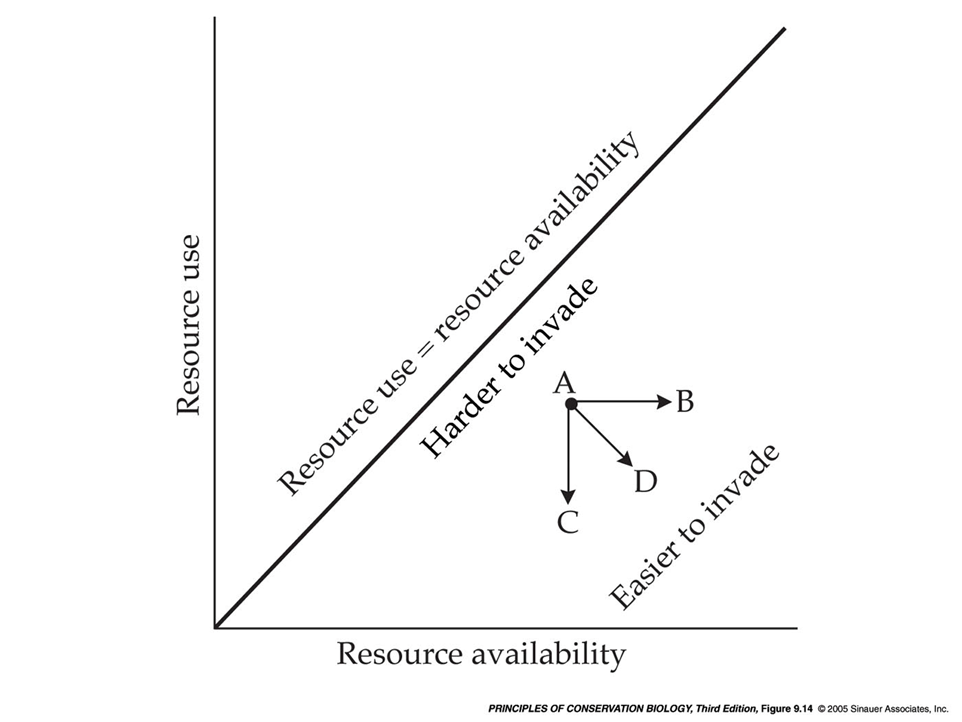invasive species
1/55
There's no tags or description
Looks like no tags are added yet.
Name | Mastery | Learn | Test | Matching | Spaced |
|---|
No study sessions yet.
56 Terms
conservation implications of invasive species
11% of plants on plains & prairies of North America are invasive; Hawaii = 35%; >3,000 spp. of invasive plants in California alone
Worldwide, 20% of endangered vertebrate spp. are threatened by invasive species (13% on mainlands, 31% on islands)
77% of fish invasions caused native species to decline
Lizards in Florida: 48 spp. invasive, 15 spp. native
San Francisco Bay: rate of successful new invasions increased from one every 55 weeks in 1851 to one every 14 weeks in 1960
These statistics are a small example of how invasions have changed the biotic makeup of land, freshwater & marine communities
Cryptogenic
applies to species whose status - native or nonnative - cannot readily be determined; commonly used for species whose cosmopolitan distribution or unclear taxonomy make their geographic origins uncertian
indigenous
synonymous to native
introduced
refers to a species that has been released outside of its native range; synonymous with nonnative, nonindigenous
introduction
the release or escape of a nonnative species
some say that its only invasive if it has negative impacts; in this class it is anything nonnative no matter what
invasion
the establishment and spread of an introduced species
invader
an introduced species
Native
Describe species that evolved in a region
nonindigenous
synonymous with introduced, nonnative
reintroduced
refers to intentionally released individuals of a native species that was locally endangered or extinct
what are the impacts of invasive species
There are 2 major considerations:
Direct and indirect effects of the invader on native species & communities.
Effects of multiple invaders
Note: ecological impacts of invasive species are inherently neither bad nor good; these judgements are made only within the context of a value framework, such as endangered species conservation, habitat restoration, or economy
Direct impacts
immediate interactions with another species thru competition, predation, parasitism, disease, or toxins. Indirect: trophic cascades, habitat modification
indirect impacts
trophic cascades, habitat modification
effects of multiple invaders
Differences in densities & behavior of invader or invaded community, or both, can lead to different impacts. Also, synergistic effects of multiple invaders (invasional meltdown)
Predators - Nile Perch
Nile perch (Lates niloticus) were introduced into Lake Victoria in the 1950’s by British Colonists to boost human food resources; native to Lake Chad, Nile River & Zaire River
The lake was home to ~400 species of cichlid fish, which are much smaller
Over the 1980’s, Nile Perch went from 1% to 97% of the total human harvest; at the same time the natives went from 92 to 0%!
200 native species disappeared!!
Today, larger fish are preferentially harvested to manage the fishery
Predators - European Red Fox
native to England
Introduced to Australia in 1855 for sport hunting
Linked to extinctions & declines in small mammals and ground nesting birds
rock wallabies vulnerable to these foxes
Predators - Rosy Wolfsnail
native to SE USA
Deliberately introduced into Hawaii to control the African Giant Snail
15 of 20 endemic snails in Hawaii went extinct due to this voracious carnivore
Brown tree snake
native to Australia, New Guinea, Solomon Islands
Accidentally introduced into Guam following World War II
Bird fauna on Guam evolved in the absence of snakes
Spread across the island causing the extinction & declines of many bird species (at least 7 extinctions)
competition - Zebra Mussels
– native to Eurasia
Introduced into North America in 1988
They settle at high densities on the shells of native mussels, reducing the natives’ ability to filter water, respire, feed and excrete wastes
40-75% of native mussels (Unionidae) are endangered largely due to zebra mussels (but also due to dams, canals, harvest, and habitat loss and degradation)
Competition - Himalayan Balsam
native to Himalayan mountains
Introduced into Europe ~100 years ago
Competes with natives for the service of pollination
Nectar produced at a very high rate – bees visit 4X more often then other native flowers
disease - malaria
causes sickness and death in humans
Native range shown (tropical)
Climate change (warming) is predicted to cause malaria to spread via mosquitos becoming invasive
Toxins - Cane Toad
native to Central & South America
Deliberately introduced into Australia in 1935 to control cane beetle
Causes lethal toxic ingestion to would-be predators
Population declines in goannas, snakes, crocodiles & quolls
Invasional meltdown
Two or more invasive species causing a synergism of impacts
We know that cane toads are causing declines & extirpations, and feral cats have done the same
It now appears that cats can fill the niches left open by monitor lizards after toads arrive
We don’t know the mechanism: predatory release, competitive release, both?

Measuring impacts on invasive species
Formula for quantifying impacts, from Parker et al (1999):
I = R X A X E
Where I = impact, R = range that the invader occupies (e.g., m2), A = its abundance over that range (e.g., numbers of biomass per m2), and E = its per capita effect (e.g., the change caused by a single individual)
Strongest impacts: those invaders with large range, high abundance an strong per capita effects
Best method = ‘before and after’ studies on absolute or relative abundance of the invader and the native species
Challenges to measuring impacts
Per capita effect difficult to determine
Lack of pre-invasion data (funding, interest, early knowledge of invasion)
Long-term nature of impacts
Difficulty in counting impacted species
What factors determine whether an invasion succeeds or fails?
Which species are the most successful invaders? Which communities are the most invasible?
1. Invasion pathway with a sufficient propagule pressure (number, frequency and quality of invading spp.) must exist
2. Invader’s physiological tolerances & life history must match the new environment well enough for survival and reproduction
3. Interactions between invader and native species must be sufficient for survival and reproduction
Note: the above can all interact
propagule pressure
number, frequency and quality of invading species
context of a filter

Propagule pressure
By definition, all invasions require a pathway that can transport species beyond their native range
The particular invasion pathway will determine the propagule pressure (quality, quantity and frequency of arriving organisms)
Two commonly recurring predictors of a successful invader are:
an association with human activity
a previous history of successful invasion
(due in part to a larger pool of source populations)
Two commonly recurring predictors of a successful invader are:
an association with human activity
a previous history of successful invasion
The higher the propagule pressure
the larger and more frequent the initial populations - the higher the chances of a successful invasion
propagule pressure is not constant
invasion pathways grow and shift, particularly due to human trade and transport
propagule pressure and small populations
Most invasions begin as small populations; they must tolerate abiotic and biotic conditions of a new environment and face problems unique to small populations, including:
Allee effect
Demographic stochasticity
Environmental stochasticity
Inbreeding depression: reduced survival and fertility of offspring of highly-related individuals
Allee effect
positive correlation between population density & individual fitness.
Mechanisms: mate finding, group defense, sex ratios, inbreeding depression
Demographic stochasticity
variability in population growth rate with population density; due to random differences among individuals in survival and reproduction
Environmental stochasticity
unpredictable variation in environmental conditions in space and/or time
inbreeding depression
reduced survival and fertility of offspring of highly-related individuals
Which species are good invaders?
Characters that enhance invasibility
High fecundity
ability to spread vegetatively
parthenogenetic or hermaphroditic reproduction
broad physiological tolerance and diet
some successful invaders will not have these traits, and some organisms with these traits may not be successful invaders
an invasion pathway may favor different characteristics than does the establishment process
invasion steps
introduction, establishment, and spread
category characteristics - successful
faster growth, wider temperature tolerance, wider salinity range
category characteristics - quickly spreading
slower growth, wider temperature tolerance, lower survival at high temperature
category characteristics - nuisance
better survival at low temperature, wider salinity tolerance, smaller eggs
quirk of fate ex Argentine ants
Argentine ants in their native range exhibit high inter-colonial aggression
Invasive populations, which are a major threat to native species, are much more cooperative among colonies, but maintain their aggression towards other species
This altered social behavior appears to have a genetic basis, and is found only in the introduced populations
Success as a “quirk of fate”
Enemy release
Introduced populations are likely to acquire new parasites and diseases in the new environment, BUT a sufficient delay may enhance its initial prospect of success
enemy release
the few introduced individuals that found a new population happen to be free of a parasite or disease
invaded community characteristics
every community is invasable given the right introduced species
if some communities are more easily invaded than others, conservation efforts could be prioritized to protect vulnerable communities
there are 2 primary features
First, the climate and habitat must be hospitable to potential invaders (e.g., the Sahara Desert may not be hospitable to most species)
Second, the species richness, interaction strength, and trophic structure of the community, must be able to accommodate new species (e.g., biotic resistance hypothesis)
biotic resistance hypothesis
species rich systems are more stable and therefore less susceptible to species invasions
Invasive tree experiment on Christmas Island
Green et al. (2004) placed seedling of 4 different tree spp. in forests and forest edges on Christmas island
caged half the seedlings to prevent predation by herbivorous crabs
in two species there was no survival in the forest interior
indirect evidence for species rich natives helping combat invasives
disturbance hypothesis for species invasions
Disturbance - either natural or anthropogenic - makes a community more invasible
this can be due to several reasons:
disturbance may make resources more available, allowing invaders to get a toehold
new forms of disturbance may disfavor native species that are not adapted to it
Invaders themselves can be agents of disturbance, altering natural disturbance regimes (fire, hydrology) by causing physical disturbance themselves, and by simply consuming other species
Resource availability and susceptibility to invasion
Increased resource availability increases a plant community’s susceptibility to invasion
The resource availability at a given time (A) could increase due to an increase in resources (B), a decline in resource use by a resident species (C), or both (D) (Davis et al., 2000)

Unintentional pathways
species can hitchhike on any type of human transport from airplanes to cars and especially ships (ballast)
ship ballasts
originally dirt was used and introduced invasives
By the late 1800’s wooden ships with solid ballasts were replaced by metal ships with water ballasts
Water is taken in through a grate, allowing plankton and even larger organisms to enter
Any that survive the voyage are released alive upon arrival
intentional pathways
Agriculture, aquaculture, recreation, erosion control, biological control & ornamental purposes
europe brought different species while colonizing
How do we manage species invasions
Eradication is usually not possible (invasive species islands are often an exception)
Control is next option
1. Physical control (trapping, hunting, digging, pulling, collecting)
2. Chemical control (pesticides, herbicides, medication)
3. Biological control (introduction of nonnative predator, parasites or diseases)
4. Multiple approaches
pitfalls of biological control
1. We may introduce a new species of pest
2. The biocontrol agent may ‘jump’ into other species
3. The biocontrol agent may spread into other countries
Invasive species control: conservation vs. ethics
If we have a proven effective control method, conservation trumps animal ethics; that is, (ethically) killing individual animals is warranted for the sake of the invaded community
If however, our control method is not effective in at least partially reversing the damage, then conservation does NOT trump animal ethics; that is, we are killing for no reason, and can be guilty of animal cruelty